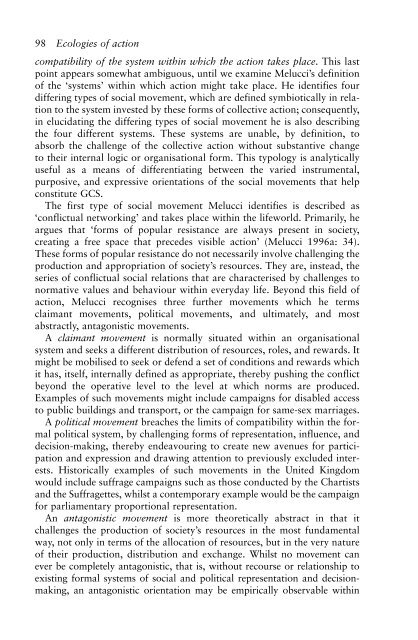Complexity and Social Movements: Multitudes at the Edge of Chaos ...
Complexity and Social Movements: Multitudes at the Edge of Chaos ...
Complexity and Social Movements: Multitudes at the Edge of Chaos ...
Create successful ePaper yourself
Turn your PDF publications into a flip-book with our unique Google optimized e-Paper software.
98 Ecologies <strong>of</strong> action<br />
comp<strong>at</strong>ibility <strong>of</strong> <strong>the</strong> system within which <strong>the</strong> action takes place. This last<br />
point appears somewh<strong>at</strong> ambiguous, until we examine Melucci’s definition<br />
<strong>of</strong> <strong>the</strong> ‘systems’ within which action might take place. He identifies four<br />
differing types <strong>of</strong> social movement, which are defined symbiotically in rel<strong>at</strong>ion<br />
to <strong>the</strong> system invested by <strong>the</strong>se forms <strong>of</strong> collective action; consequently,<br />
in elucid<strong>at</strong>ing <strong>the</strong> differing types <strong>of</strong> social movement he is also describing<br />
<strong>the</strong> four different systems. These systems are unable, by definition, to<br />
absorb <strong>the</strong> challenge <strong>of</strong> <strong>the</strong> collective action without substantive change<br />
to <strong>the</strong>ir internal logic or organis<strong>at</strong>ional form. This typology is analytically<br />
useful as a means <strong>of</strong> differenti<strong>at</strong>ing between <strong>the</strong> varied instrumental,<br />
purposive, <strong>and</strong> expressive orient<strong>at</strong>ions <strong>of</strong> <strong>the</strong> social movements th<strong>at</strong> help<br />
constitute GCS.<br />
The first type <strong>of</strong> social movement Melucci identifies is described as<br />
‘conflictual networking’ <strong>and</strong> takes place within <strong>the</strong> lifeworld. Primarily, he<br />
argues th<strong>at</strong> ‘forms <strong>of</strong> popular resistance are always present in society,<br />
cre<strong>at</strong>ing a free space th<strong>at</strong> precedes visible action’ (Melucci 1996a: 34).<br />
These forms <strong>of</strong> popular resistance do not necessarily involve challenging <strong>the</strong><br />
production <strong>and</strong> appropri<strong>at</strong>ion <strong>of</strong> society’s resources. They are, instead, <strong>the</strong><br />
series <strong>of</strong> conflictual social rel<strong>at</strong>ions th<strong>at</strong> are characterised by challenges to<br />
norm<strong>at</strong>ive values <strong>and</strong> behaviour within everyday life. Beyond this field <strong>of</strong><br />
action, Melucci recognises three fur<strong>the</strong>r movements which he terms<br />
claimant movements, political movements, <strong>and</strong> ultim<strong>at</strong>ely, <strong>and</strong> most<br />
abstractly, antagonistic movements.<br />
A claimant movement is normally situ<strong>at</strong>ed within an organis<strong>at</strong>ional<br />
system <strong>and</strong> seeks a different distribution <strong>of</strong> resources, roles, <strong>and</strong> rewards. It<br />
might be mobilised to seek or defend a set <strong>of</strong> conditions <strong>and</strong> rewards which<br />
it has, itself, internally defined as appropri<strong>at</strong>e, <strong>the</strong>reby pushing <strong>the</strong> conflict<br />
beyond <strong>the</strong> oper<strong>at</strong>ive level to <strong>the</strong> level <strong>at</strong> which norms are produced.<br />
Examples <strong>of</strong> such movements might include campaigns for disabled access<br />
to public buildings <strong>and</strong> transport, or <strong>the</strong> campaign for same-sex marriages.<br />
A political movement breaches <strong>the</strong> limits <strong>of</strong> comp<strong>at</strong>ibility within <strong>the</strong> formal<br />
political system, by challenging forms <strong>of</strong> represent<strong>at</strong>ion, influence, <strong>and</strong><br />
decision-making, <strong>the</strong>reby endeavouring to cre<strong>at</strong>e new avenues for particip<strong>at</strong>ion<br />
<strong>and</strong> expression <strong>and</strong> drawing <strong>at</strong>tention to previously excluded interests.<br />
Historically examples <strong>of</strong> such movements in <strong>the</strong> United Kingdom<br />
would include suffrage campaigns such as those conducted by <strong>the</strong> Chartists<br />
<strong>and</strong> <strong>the</strong> Suffragettes, whilst a contemporary example would be <strong>the</strong> campaign<br />
for parliamentary proportional represent<strong>at</strong>ion.<br />
An antagonistic movement is more <strong>the</strong>oretically abstract in th<strong>at</strong> it<br />
challenges <strong>the</strong> production <strong>of</strong> society’s resources in <strong>the</strong> most fundamental<br />
way, not only in terms <strong>of</strong> <strong>the</strong> alloc<strong>at</strong>ion <strong>of</strong> resources, but in <strong>the</strong> very n<strong>at</strong>ure<br />
<strong>of</strong> <strong>the</strong>ir production, distribution <strong>and</strong> exchange. Whilst no movement can<br />
ever be completely antagonistic, th<strong>at</strong> is, without recourse or rel<strong>at</strong>ionship to<br />
existing formal systems <strong>of</strong> social <strong>and</strong> political represent<strong>at</strong>ion <strong>and</strong> decisionmaking,<br />
an antagonistic orient<strong>at</strong>ion may be empirically observable within




